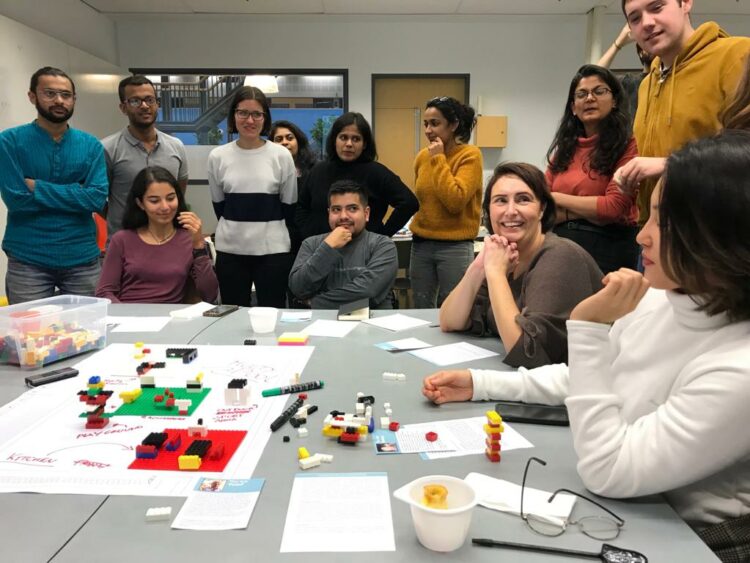Reflecting on participatory design practices through an interactive HPM seminar
Malena López Reyes and Alberto Magni, two master design students researching participatory processes for their Honours Programme, joined forces in setting up their HPM Seminar for the concluding activity of their respective research journeys.
Titled “Reflecting on the benefits and conditions of enriching participation”, the seminar was organised with the aim of prompting a reflection with peer researchers, designers and practitioners on how to create the right conditions to foster participation in design processes and benefits for the ones participating in them.
From her side Malena’s research addressed the participatory approaches used to engage citizens in city-making projects. She focused her investigation in Delft’s context, trying to unveil the conditions to create safe spaces for participation, namely ones that make citizens feel welcome to express their worries, needs, and desires. On his part, Alberto aimed at understanding what it means to take part in a participatory design process really means for the participants involved. Looking in particular at what are the benefits that participants may gain by taking part in participatory design projects and how designers can work to enhance them.
“Imagine you are Yusuf”: Turning the seminar into a speculative design activity
Malena and Alberto collaborated to utilize the HPM Seminar to get a richer perspective on their topics. They did so by sharing their interim results with peers interested in participatory processes, but in particular, they turned the seminar into a speculative design activity through which both of them could investigate some specific aspects of their research.
The investigation was twofold. On the one hand, Malena’s interest was in fostering power dynamics within participants to trigger them to reflect on the best practices when making a collective decision. She used the insights gained on participatory design practice in Delft’s municipality to point out moments of reflections for participants to open the discussion. On the other hand, Alberto was interested in stimulating participants to think of which factors may help citizens get involved in participatory activities while developing ownership of the process and the designer tools and diversify their use
The first activity they carried out consisted of a speculative design exercise to simulate co-creation. Alberto and Malena asked the participants in the seminar to enact a community of neighbours who needed to discuss and agree on the project development plan for their imaginary neighbourhood. Each participant had to embody a different “Persona” representing a member of the neighbourhood. Then, through a co-creation technique called ‘Lego-Serious-Play,’ these imaginary community members could discuss and built together the agreed development plan.

The experience of discussing, agreeing, and using a designerly tool to develop a plan for their neighbourhood prepared participants to get to the core of the researchers’ investigation, and unveil insights through a series of reflective activities.
What followed indeed was a reflection exercise, proposed by Malena, in which participants had to think and discuss upon eight different moments that she identified to be crucial in allowing the conditions for open and engaged participation; this discussion was carried out as a community embodying their fictional characters.

A second reflection moment was carried out focusing on Alberto’s research on enabling citizens to appropriate designer tools and methods. In particular, participants were asked to think of what helped their personas understand the tools experienced in the session and how they use them in their own life.
Finally, every participant in the seminar shared their thoughts about their engagement and involvement in the activity, taking into consideration their role and their personas’ needs for participating and feeling safe in their involvement.
Benefits from this participatory activity
If the exercise was just an imaginary situation with fictional characters, the interactions taking place in each group of participants led towards in-depth discussions that would otherwise go unnoticed. The speculative design activity and the following reflective questions gave both researchers great insights to refine and conclude their research.
Alberto learned a lot on what facilitates participants in appropriating the tools they experience during design activities. Facilitation from expert designers showed as one of the main supports for the comprehension of tools by participants, but is not the only one. Participants said that their personas were facilitated to understand the tool by the collective effort of other participants. “Doing things together” encouraged participants to engage more deeply with the activity and the fact that the tool was tangible and “that you could play with it”, as a participant wrote, were additional elements that helped ‘personas’ to take ownership of it during the activity. These and other insights added to Alberto’s previous findings on the benefits of participation from the perspective of participants, and helped him formulate a list of guidelines to design for enriching participatory activities.
Malena, on her side, gained useful insights to iterate and formulate her proposed framework of a Safe Participatory city-making process. During the first activity, the reflection moments proved to be triggers of a deep discussion in all teams regarding the best practices during the planning of a participatory process. The insights gathered were used to derive into a proposed framework to design a safe Participatory city-making process that could help practitioners pay attention to certain aspects that will help citizens feel safer during participation. The activity evidenced the dynamicity and non-linearity of participation.
Above all, the co-creation exercise resulted in a fun and rich way to gather information. The discussions triggered by participants were wide and deep and the data collected helped both researchers involved to validate and enrich their work.
Overall, this experience showed how valuable it can be to set up, throughout an individual research journey such as the HPM programme, a moment for sharing your work with a larger community of peers. In particular, the event described in this article was made even more fruitful by turning a seminar into an engaging and participatory activity upon which to reflect together. We could say, indeed, showing the benefits of participation!